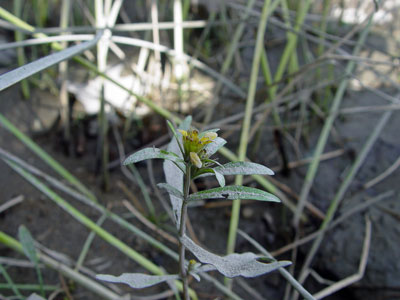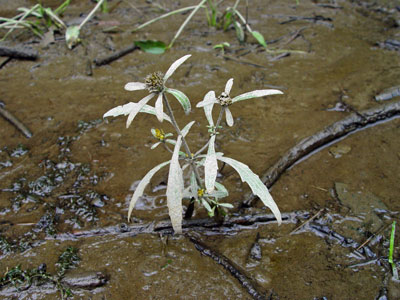DACF Home → Bureaus & Programs → Maine Natural Areas Program → Communities, Plants, and Animals → Rare Plants → Bidens hyperborea
Bidens hyperborea Greene

Estuary Bur-marigold
- State Rank: S3
- Global Rank: G4
- State Status: Special Concern
Habitat: Localized in fresh to brackish estuaries. [Tidal wetland (non-forested, wetland)]
Range: Massachusetts to Nova Scotia and Quebec.
Aids to Identification: Bur-marigolds are herbaceous plants with yellow daisy-like or button-like flowers and opposite leaves. The term "bur-marigold" refers to the "sticktight" seeds which attach themselves readily to clothing or fur. B. hyperborea differs from other Maine bur-marigolds in the following combination of characters: the leaves are simple (as opposed to compound) and without stalks, and the heads are usually erect (as opposed to the common nodding beggar ticks, B. cernua). For certain identification, one must look at the fruits (cypselas) which in B. hyperborea are coarsely striate and have a convex, cartilagenous apex. This species is presently divided into several varieties, two of which are known to occur in Maine. Most specimens are not distinguished to variety.
Ecological characteristics: Bidens hyperborea is characteristic of tidal estuaries and occupies mudflats. In some cases it has been found with B. eatonii, which has stalked leaves.

Phenology: Flowers August - September
Family: Asteraceae
Synonyms: Bidens hyperborea Greene var. cathancensis Fern.; Bidens hyperborea Greene var. colpophila (Fern. & St. John) Fern.; Bidens hyperborea Greene var. laurentiana Fassett; Bidens hyperborea Greene var. svensonii Fassett.
Known Distribution in Maine: This rare plant has been documented from a total of 25 town(s) in the following county(ies): Hancock, Kennebec, Lincoln, Penobscot, Sagadahoc, Waldo, York.
Reason(s) for rarity: A polymorphic species with varieties restricted to specific geographic areas.
Conservation considerations: Prevent degradation of marsh and estuary habitat from adjacent land uses.